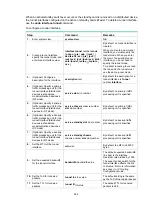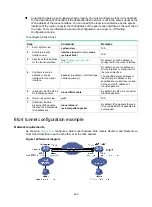
304
Configuration example
Network requirements
As shown in
, configure an ISATAP tunnel between the router and the ISATAP host so the
ISATAP host in the IPv4 network can access the IPv6 network.
Figure 126 Network diagram
Configuration procedure
•
Configure the router:
# Specify an IPv6 address for GigabitEthernet 2/0/2.
<Router> system-view
[Router] interface gigabitethernet 2/0/2
[Router-GigabitEthernet2/0/2] ipv6 address 3001::1/64
[Router-GigabitEthernet2/0/2] quit
# Specify an IPv4 address for GigabitEthernet 2/0/1.
[Router] interface gigabitethernet 2/0/1
[Router-GigabitEthernet2/0/1] ip address 1.1.1.1 255.0.0.0
[Router-GigabitEthernet2/0/1] quit
# Create the ISATAP tunnel interface Tunnel 0.
[Router] interface tunnel 0 mode ipv6-ipv4 isatap
# Specify an EUI-64 IPv6 address for the tunnel interface.
[Router-Tunnel0] ipv6 address 2001:: 64 eui-64
# Specify GigabitEthernet 2/0/1 as the source interface of the tunnel interface.
[Router-Tunnel0] source gigabitethernet 2/0/1
# Disable RA suppression so that the ISATAP host can acquire information such as the address
prefix from the RA message advertised by the ISATAP router.
[Router-Tunnel0] undo ipv6 nd ra halt
[Router-Tunnel0] quit
•
Configure the ISATAP host:
Configurations on the ISATAP host vary by operating system. The following configuration is
performed on Windows XP.
# Install IPv6.
C:\>ipv6 install
# On a host running Windows XP, the ISATAP interface is typically interface 2. Display
information about the ISATAP interface.
C:\>ipv6 if 2
Interface 2: Automatic Tunneling Pseudo-Interface
Guid {48FCE3FC-EC30-E50E-F1A7-71172AEEE3AE}
does not use Neighbor Discovery
















































